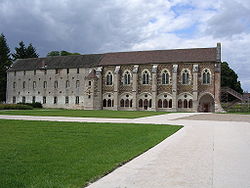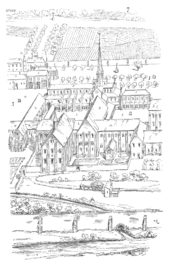
Cîteaux Abbey
Encyclopedia

Abbey
An abbey is a Catholic monastery or convent, under the authority of an Abbot or an Abbess, who serves as the spiritual father or mother of the community.The term can also refer to an establishment which has long ceased to function as an abbey,...
located in Saint-Nicolas-lès-Cîteaux
Saint-Nicolas-lès-Cîteaux
Saint-Nicolas-lès-Cîteaux is a commune in the Côte-d'Or department in eastern France.Cîteaux Abbey is located in the commune.-Population:-References:*...
, south of Dijon
Dijon
Dijon is a city in eastern France, the capital of the Côte-d'Or département and of the Burgundy region.Dijon is the historical capital of the region of Burgundy. Population : 151,576 within the city limits; 250,516 for the greater Dijon area....
, France
France
The French Republic , The French Republic , The French Republic , (commonly known as France , is a unitary semi-presidential republic in Western Europe with several overseas territories and islands located on other continents and in the Indian, Pacific, and Atlantic oceans. Metropolitan France...
. Today it belongs to the Trappists
Trappists
The Order of Cistercians of the Strict Observance , or Trappists, is a Roman Catholic religious order of cloistered contemplative monks who follow the Rule of St. Benedict...
, or Cistercians of the Strict Observance (OCSO). The Cistercian order takes its name from this mother house of Cîteaux, earlier Cisteaux, near Nuits-Saint-Georges
Nuits-Saint-Georges
Nuits-Saint-Georges is a commune in the arrondissement of Beaune of the Côte-d'Or department in eastern France. It lies in the Burgundy region.-Wine:Nuits-Saint-Georges is the main town of the Côte de Nuits wine-producing area of Burgundy...
. The abbey has about 35 members.
History
Cîteaux Abbey was founded in 1098 by a group of monks from Molesme AbbeyMolesme Abbey
Molesme Abbey was a well-known Benedictine monastery in Molesme, in Laignes, Côte-d'Or, Burgundy, on the border of the Dioceses of Langres and Troyes.-History:...
, seeking to follow more closely the Rule of St. Benedict, under the leadership of Saint Robert of Molesme
Robert of Molesme
Saint Robert of Molesme was a Christian saint and abbot, one of the founders of the Cistercian Order in France.-Life:Robert was a member of the nobility in Champagne, a younger son, who entered the abbey of Montier-la-Celle, near Troyes, at age fifteen and later rose to the status of prior...
, who became the first abbot
Abbot
The word abbot, meaning father, is a title given to the head of a monastery in various traditions, including Christianity. The office may also be given as an honorary title to a clergyman who is not actually the head of a monastery...
, Saint Alberic, the second abbot, and Saint Stephen Harding
Stephen Harding
Saint Stephen Harding is a Christian saint and abbot, one of the founders of the Cistercian Order.-Life:Stephen Harding was born in Dorset, England. He was placed in Sherborne Abbey at a young age, but eventually put aside the cowl and became a travelling scholar. He eventually moved to Molesme...
the third abbot, who wrote the Carta Caritatis, that described the organisation of the order.

Clairvaux Abbey
Clairvaux Abbey is a Cistercian monastery in Ville-sous-la-Ferté, 15 km from Bar-sur-Aube, in the Aube département in northeastern France. The original building, founded in 1115 by St. Bernard, is now in ruins; a high-security prison, the Clairvaux Prison, now occupies the grounds...
in 1115, of which he was the first abbot. His influence in the Cistercian order and beyond is of prime importance. He reaffirmed the importance of strict observance to the Rule of St. Benedict.
The great church of Cîteaux Abbey, begun in around 1140, was completed in 1193. The Dukes of Burgundy subsequently used as their dynastic place of burial.
The influence of the Cistercian order grew very rapidly, owing much to Saint Bernard, and at the beginning of the 13th century the order had more than 500 houses. Cîteaux was then an important center of Christianity. In 1244, King Louis IX of France
Louis IX of France
Louis IX , commonly Saint Louis, was King of France from 1226 until his death. He was also styled Louis II, Count of Artois from 1226 to 1237. Born at Poissy, near Paris, he was an eighth-generation descendant of Hugh Capet, and thus a member of the House of Capet, and the son of Louis VIII and...
(Saint Louis) and his mother Blanche of Castile
Blanche of Castile
Blanche of Castile , was a Queen consort of France as the wife of Louis VIII. She acted as regent twice during the reign of her son, Louis IX....
visited the abbey.
During the Hundred Years' War
Hundred Years' War
The Hundred Years' War was a series of separate wars waged from 1337 to 1453 by the House of Valois and the House of Plantagenet, also known as the House of Anjou, for the French throne, which had become vacant upon the extinction of the senior Capetian line of French kings...
, the monastery was pillaged in 1360 (when the monks sought refuge in Dijon), 1365, 1434 and 1438.
In the beginning of the 16th century, the abbey was a strong community of about 200 members. The abbey was badly hit by the French Wars of Religion
French Wars of Religion
The French Wars of Religion is the name given to a period of civil infighting and military operations, primarily fought between French Catholics and Protestants . The conflict involved the factional disputes between the aristocratic houses of France, such as the House of Bourbon and House of Guise...
.
The abbey then slowly declined for the next century. In 1698, the abbey only had 72 professed monks.
In 1791, during the French Revolution
French Revolution
The French Revolution , sometimes distinguished as the 'Great French Revolution' , was a period of radical social and political upheaval in France and Europe. The absolute monarchy that had ruled France for centuries collapsed in three years...
, the abbey was seized and sold by the government.
In 1898, the remains of the abbey were bought back and repopulated by monks of other abbeys.
Current activities
The monks, faithful to a tradition of manual work, sell their products to the public: the well reputed Cîteaux cheese, but also honey sweets and caramels.External links
- Official site (in French)
- History of Cîteaux Abbey (in French)

